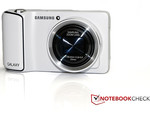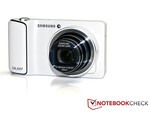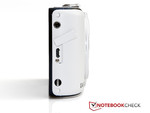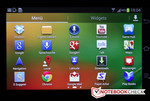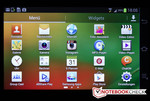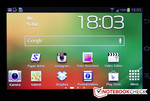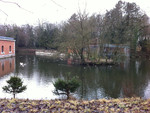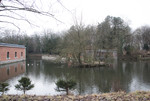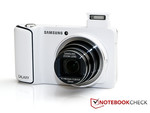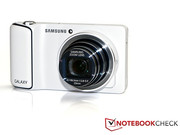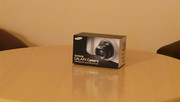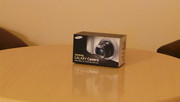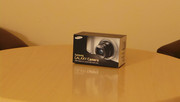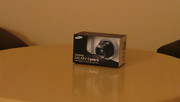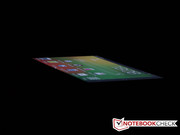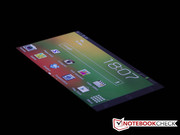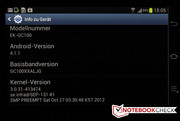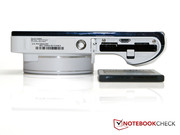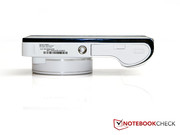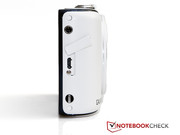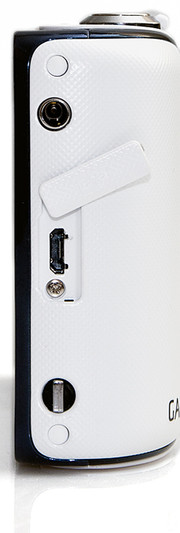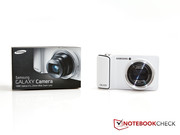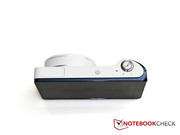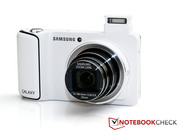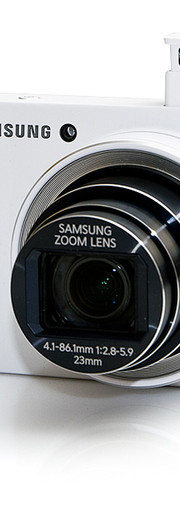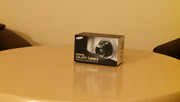Review Samsung Galaxy Camera

For the original German review, see here.
Just to make something clear from the outset of this review: The Samsung Galaxy Camera is not a smartphone. A micro SIM card can be inserted, but it's only for data transfer. You can't have conversations over the Samsung Galaxy Camera. In exchange, the camera possesses a wide palette of other features. Starting with the photographic quality, the Samsung Galaxy Camera offers a CMOS sensor with a resolution of 16 megapixels, 21x optical zoom, an image stabilizer and a GPS. We can also look at the features we'll call "tablet-like." The camera is powered by a Cortex A9 quad-core with 1.4 GHz - and there's Wi-Fi, 3G and Android version 4.1. We'll discover in this review how the Samsung Galaxy Camera does, and whether it's more valuable than your average compact camera.
Case
This first time you pick up the Samsung Galaxy Camera, you notice how heavy it is: at about 300 grams (10.6 oz) it's certainly not a light device. But on the flip side, the camera feels substantial in your hand. The padded grip on the right side offers enough room to hold the camera securely, and it gives you the sense that there's no need to fear it slipping out of your hands. We feel like the grip could have been bigger, but surely that's a matter of taste and won't be taken into account in our ratings. The touchscreen takes up the whole back panel and is surrounded by a small metal frame. On the bottom there's a standard tripod socket, making it possible to screw the camera into most common tripods. In regards to manufacturing quality, the Galaxy Camera has nothing to hide; though you should be careful with the cover, seeing as it's only made of thin plastic.
Connectivity
In terms of connectivity options, the Samsung Galaxy Camera offers firstly the obligatory mini-USB port. Videos can be transmitted directly through the micro-HDMI output. There's also a 3.5 mm jack for headphones. For those who need more memory space than the internal memory provides, this can be expanded with a micro-SD card. The accepted formats are SC, HC and XC. The maximum size of the SD card is 64 GB. A micro-SD card is probably a necessity, since the internal memory only holds 4 GB - which, of course, fills up very quickly.
Communication
Uncommonly for a camera, the Samsung Galaxy Camera offers the same communication options found in current smartphones or tablets. Along with Wi-Fi a/b/g/n, 3G and a GPS receiver are also on board. Bluetooth in version 4.0 of course also needed to be included. Which mobile technologies are on board each specific camera depends on which variant of the device you choose to buy. There's one version with only Wi-Fi and another with both WiFi and mobile communication technology (as we have here in our review.)
Software
Samsung uses Android version 4.1.1 in its Galaxy Camera. As in the Samsung Galaxy S3 (which has a lot in common with the Galaxy Camera), the Galaxy Camera employs the TouchWiz user interface. All in all, the interface feels clearly arranged and clean. Samsung delivers a variety of apps with the Galaxy Camera; for instance, alongside the usual Google apps, there's an app for Dropbox or Instagram directly on the camera. Happily, Samsung chose to go without so-called "bloatware," so you don't need to clean up the system on your first start-up.
Packaging
In the Galaxy Camera's packaging you find, of course, the camera itself, the appropriate battery, a small hand-strap, a USB charging cable including a 230 V plug and the usual printed documents regarding the warranty, which happens to be 12 months.
Input Devices
The touchscreen on the back side of the camera functions quickly and fluidly. As per usual with the Galaxy series smartphones, the touchscreen could hardly react better to input. Thanks to multitouch technology, simultaneous input from multiple fingers is recognized and implemented, as far as the use of this function is supported. There shouldn't be any problems in operating the tablet/smartphone functions, since many time-tested features were taken from the smartphone/tablet arena - an arena in which Samsung, as a big manufacturer, has quite a bit of experience.
When it comes to the camera functions, things look a little different. Apart from the operation elements for the zoom, the shutter release and the button that extends the flash, there aren't any other operational controls to manipulate settings on the camera body. Instead, you always have to go back to the screen of the camera to work through the menu on the touchscreen. That takes up precious time when you're talking about fleeting opportunities for shots.
Display
In the Galaxy Camera Samsung uses a 12.19 cm (4.8 inch) HD Super Clear Touch Display. The display has a resolution of 1280x720 pixels, which corresponds to the HD format. The display's pixel density is at 306 PPI; at 326 PPI the Apple iPhone5 only has a marginal lead. Besides the display function for images and the Android interface, the touch display is also a main interface for the operation of the camera, since there are hardly any other buttons dedicated to camera function (there are shutter, zoom, power and flash buttons). With its 4.8 inch display, the screen is uncommonly large for a digital camera, which makes it easy to see captured photos. Navigation through the Android operating system functions excellently. Compared with other camera's touchscreens, the Samsung Galaxy Camera clearly triumphs. Users who already have experience with smartphones (and especially those with a Samsung Galaxy) will take no time at all to become familiar with the camera.
| |||||||||||||||||||||||||
Brightness Distribution: 87 %
Center on Battery: 310 cd/m²
Contrast: 810:1 (Black: 0.39 cd/m²)
Another highlight is the high brightness level of the display. With a maximum value of 336 cd/m2 and an average brightness of 312.9 cd/m2, the display is very bright. At 87%, the illumination level isn't the most homogeneous we've ever seen; but on such a small surface as a camera's display the brightness differentiations barely matter, since the human eye can't actually recognize them. The black value of 0.39 cd/m2 makes for a respectable contrast of 810:1.
Seeing as you often use a camera out in the fresh air and sunshine, it's important that you can still see the camera's display content in those kinds of situations, especially if the camera's settings are controlled via the touchscreen. The display does have a reflective surface, but the high brightness level compensates for that drawback. At a brightness level of over 300 cd/m2, reading the display out in the sunshine shouldn't be a problem.
Performance
Samsung relies on the same processor they used in the Galaxy S3. The Exynos 4 Quad System-on-a-Chip (SoC) based on the ARMv7 architecture with a Coretex-A9 quad-core processor provides 1.4 GHz per core. With that processor the Galaxy Camera, like the Galaxy S3, possesses a solid basis for performance.
The camera's similarity to the Galaxy S3 can be recognized in the benchmark results as well. In most cases, the Galaxy S3 and the Galaxy Camera lay side by side. With only 4 GB of memory space, the Galaxy Camera is clearly at a disadvantage compared with the Galaxy S3 and falls behind in some areas.
In regards to the browser-based benchmarks, the Galaxy Camera did very well. While both the Galaxy S3 as well as the Nexus 4 come in a little before the Galaxy Camera in the Browsermark benchmark, in the Google V8 Ver.7 benchmark the Galaxy Camera trumped the Nexus 4. Still, the Galaxy Camera doesn't catch up with the Galaxy S3.
All in all, the Galaxy Camera has to admit defeat in the face of the Samsung Galaxy S3. Subjectively, however, you could say that the former works just as well. In our test, all sorts of tasks were executed fluidly and quickly. There were no noticeable skips or delays.
| Google V8 Ver. 7 - Google V8 Ver. 7 Score (sort by value) | |
| Samsung Galaxy Camera EK-GC100ZWADBT | |
| Samsung Galaxy S3 | |
| Google Nexus 4 | |
| HTC One X | |
| Browsermark - --- (sort by value) | |
| Samsung Galaxy Camera EK-GC100ZWADBT | |
| Samsung Galaxy S3 | |
| Google Nexus 4 | |
| Sunspider - 0.9.1 Total Score (sort by value) | |
| Samsung Galaxy Camera EK-GC100ZWADBT | |
| Samsung Galaxy S3 | |
| Google Nexus 4 | |
| HTC One X | |
| AndroBench 3-5 | |
| Random Read 4KB (sort by value) | |
| Samsung Galaxy Camera EK-GC100ZWADBT | |
| Samsung Galaxy S3 | |
| Google Nexus 4 | |
| Random Write 4KB (sort by value) | |
| Samsung Galaxy Camera EK-GC100ZWADBT | |
| Samsung Galaxy S3 | |
| Google Nexus 4 | |
| Sequential Read 256KB (sort by value) | |
| Samsung Galaxy Camera EK-GC100ZWADBT | |
| Samsung Galaxy S3 | |
| Google Nexus 4 | |
| Sequential Write 256KB (sort by value) | |
| Samsung Galaxy Camera EK-GC100ZWADBT | |
| Samsung Galaxy S3 | |
| Google Nexus 4 | |
* ... smaller is better
Graphic output is covered by an ARM Mali-400 MP4 GPU in the Samsung Galaxy Camera. In the Nena Mark 2 benchmark the Samsung Galaxy Camera lies a little behind the Galaxy S3 and the Nexus 4 once again, which are comparable in this area. But the Galaxy Camera leaves the HTC One X far behind.
In the current GL benchmark version 2.5 our test model is clearly beat out by the Nexus 4. The Galaxy S3 unfortunately doesn't appear in this benchmark, since when we tested the S3 the GL benchmark version 2.1 was still in use, which is no longer available in the Android store.
| NenaMark2 - --- (sort by value) | |
| Samsung Galaxy Camera EK-GC100ZWADBT | |
| Samsung Galaxy S3 | |
| HTC One X | |
| Google Nexus 4 | |
| GLBenchmark 2.5 - Egypt HD Fixed Time (sort by value) | |
| Samsung Galaxy Camera EK-GC100ZWADBT | |
| Samsung Galaxy S3 | |
| Google Nexus 4 | |
But first and foremost the Samsung Galaxy Camera should be a camera, as the name asserts. It's a little strange at first to have to wait a while for the camera to boot before it's fully operational. Upon start-up, you first find yourself in the photo app. The display on the back shows your current possible snapshot as well as all the operational controls for the photo. On the right side there's a menu for choosing the picture mode. Besides the classic modes like fully automatic, aperture priority, shutter priority, and the manual mode, there are also so-called "intelligent modes." Intelligent modes are specific picture modes suited to photographing particular kinds of scenes. There are programs for panoramas, night shots, fireworks, portraits and a variety of other circumstances.
Along the bottom edge of the picture, there's a menu with possible filters for the photo. Here too Samsung provides a breadth of possibilities, from a black-and-white filter and a sepia filter to a comic filter. The selection is satisfactorily extensive and varied.
The auto-focus makes a good impression and generally finds the focus very quickly at low zoom levels. The shutter-release delay is also very short. Neither of those values reaches anything like the levels of a DSLR, but the Galaxy Camera can easily keep up with the compact cameras on the markets. Compared to cell phone cameras, both the focus and the trigger speed are quite a bit quicker. At the maximum zoom level, though, the focus is no longer as easy. It's obvious how much the focus pumps back and forth before it finally finds the focus point. Additionally, due to the image stabilizer there's a clear delay in the display of the picture. Because the image stabilizer has a lot to do at high focal lengths, you notice how the image sometimes has a hard time keeping up with movement. You notice the effect more strongly especially when panning along the horizontal axis.
The voice control is a particularly interesting feature. When activated, this allows the user to control certain functions of the camera through keywords. For instance, a "smile" or "please smile" causes the camera to independently focus and take a shot. Through the same means you can start recording a video, change the zoom or look at the gallery.
In summary, when it comes to capturing images, Samsung put a lot of effort into making the Galaxy Camera's functions practical and intuitive through the touch interface. In our opinion, they did a good job. The only problems are that the camera gets into a bit of a sweat at higher zoom levels, and anyone who wants to work in the manual mode will have to fight through the menu for each setting change.
Picture quality
On the question of picture quality, the verdict depends entirely on what measurement you use to assess the quality of the Galaxy Camera's photos. If you compare the pictures with those of current smartphones, the Galaxy Camera is far superior. In comparison with compact cameras our review model does a respectable job, though here we're talking about comparable quality. Compared with a low-end DSLR (in this case a Canon 600D), the Galaxy Camera is the clear loser.
In our test photos, which admittedly weren't taken in the best of weather, there's a little sharpness missing in the images. We left the camera in automatic mode, since we are assuming that most buyers will generally be taking pictures in this mode. The values chosen by the camera were fully acceptable.
ISO
The Samsung Galaxy Camera has an ISO range of 100-3200. In our exposure bracket, the photos with ISO values of 100 to 400 are entirely satisfactory. Even at closer look there isn't any noticeable noise. At an ISO of 800 noise slowly starts to creep in; in the darker areas it's already clearly visible. In addition, as the noise suppression becomes more active, you can see how the image loses detail. At an ISO of 1600 all of this is amplified. Finer details are softened and are no longer very recognizable, but if you don't zoom into the photo it's still usable. At an ISO of 3200 the image noise is obvious, and the image becomes even "softer". We must emphasize, though, that in our test images there is only a negligible amount of color noise.
Emissions
Temperature
The Samsung Galaxy Camera is only cooled through the case. In this point the camera seems to profit greatly from its metal case. The Galaxy S3, with almost the same hardware configuration, becomes noticeably warmer under load. At a maximum temperature of 36.2 degrees Celsius (97.2 degrees Fahrenheit), the Galaxy Camera is in a range hardly worth mentioning. Over longer periods of use there's still no sign of the camera heating up much.
(+) The maximum temperature on the upper side is 36.2 °C / 97 F, compared to the average of 33.7 °C / 93 F, ranging from 20.7 to 53.2 °C for the class Tablet.
(+) The bottom heats up to a maximum of 32.4 °C / 90 F, compared to the average of 33.2 °C / 92 F
(+) In idle usage, the average temperature for the upper side is 30.4 °C / 87 F, compared to the device average of 30 °C / 86 F.
Speakers
The speaker is located under the flash button, in the front on the right side of the camera. Due to the size of the speaker, it has decent sound. Higher tones are reproduced well; only lower tones and/or bass tones basically disappear. The volume is respectable, though it could certainly be a little louder. Since the volume controls on smartphones are absent on the Galaxy Camera, Samsung integrated the volume control into the zoom. Unlike with smartphones, headphones are not included in the packaging.
Energy consumption
To look at the energy consumption of the Samsung Galaxy Camera, we once again orient ourselves towards the Galaxy S3. We do this in part because the two devices have nearly identical hardware, and in part because there's not yet another device on the market to compare with the Galaxy Camera.
In idle mode the two devices lie pretty close together: While the Galaxy Camera needs a little less at the minimum load (0.5 Watts camera/1.2 Watts S3), the camera needs a little more at the maximum (1.9 Watts camera/1.5 Watts S3). Under load, however, the camera clearly uses more energy. At 4.5 Watts, the Galaxy Camera needs almost a whole Watt more than the Galaxy S3.
| Off / Standby | |
| Idle | |
| Load |
|
Key:
min: | |
Battery life
In idle mode the Galaxy Camera's battery life comes to 10 hours and 44 minutes. For this test almost all means of communication, like Bluetooth, GPS etc. are deactivated and the display brightness is dialed down to a minimum. Only the WLAN is active, and a script is running that simulates the reading of an e-book. In practice, however, this situation will never happen; the closest you might come is leaving the camera sitting while still turned on. Because you can't completely deactivate the integrated timer, however, after a maximum of half an hour the camera would turn off itself.
Under full load the battery lasts 2 hours and 14 minutes. For this test all means of communication are activated and the display brightness is set to its maximum. In order to use the hardware to its full capacity the program StabilityTest v2.7 is run.
The battery is a special battery that can only be loaded through the camera. An extra charging set, as you find with some other cameras, is not included. For photographers who like to keep one battery in the camera and another battery in the charger, this could end up being a problem. The battery Samsung chose for the camera (EB-F1A2GBU) is the same one they used in the Samsung Galaxy S2, which means it shouldn't be a problem to find and purchase another one.
Verdict
More of a camera than a smartphone -- that much you can say about the Samsung Galaxy Camera in the end. With the Galaxy Camera, Samsung brought an interesting and versatile product to the market and simultaneously created a new product class.
As we have experienced with other Samsung devices, the camera case gleams with solid manufacturing quality and a good choice of material. The camera feels substantial, and the fusion of the touchscreen with the camera is well done.
Input through the touchscreen works very well both in tablet-mode and for photography and it glistens with its excellent responsiveness and high level of accuracy. The value of the touchscreen itself is also convincing, even if the colors are a little distorted at certain angles of vision.
The hardware's performance is also as satisfactory as it could be, though it always lags a little behind the Samsung Galaxy S3.
But now we come to the main focus, namely the actual camera function. Samsung did a good job with the controls via the touchscreen, and it's easy to use as long as you can make do with automatic programs. If you switch into the half-automatic or manual modes, though, changing settings becomes arduous.
The camera's photos aren't 100% convincing. Smartphone cameras clearly have no chance against the Galaxy Camera. We would put this product in the category of the compact camera, where the Galaxy Camera is comparable to much of the rest of the competition in terms of picture quality. Against entry-level DSLRs the Galaxy Camera has to admit defeat.
And here lies the camera's biggest problem: You can get a cheap DSLR with a lens for less money than the Galaxy Camera. Since it's "only" a camera with internet connection, it can't replace a smartphone and therefore ends up being another device you have to carry around. If you're going to have to carry another device along anyway, you could also choose a cheaper compact camera, or a DSLR with better picture quality. But if you can't wait to upload your photos to the internet and want to be able to do it while you're out and about, the Galaxy Camera would definitely be worth your while.




